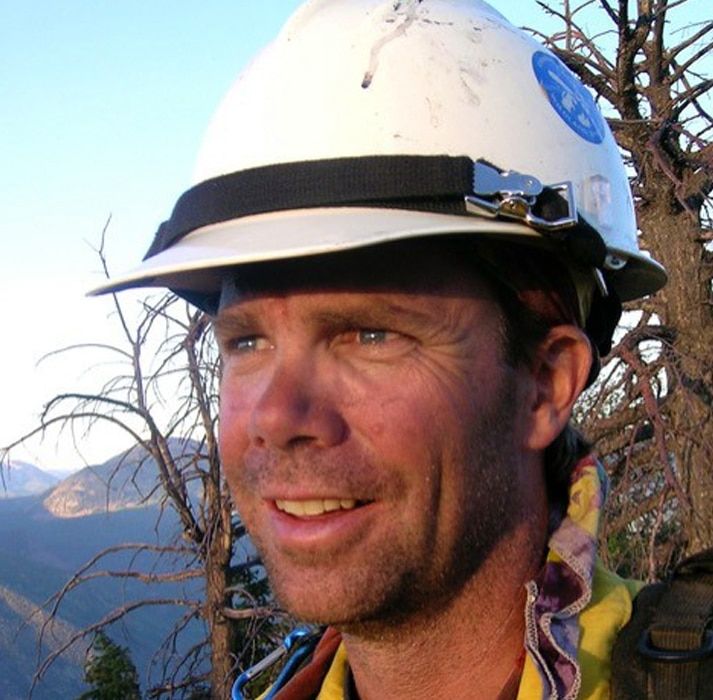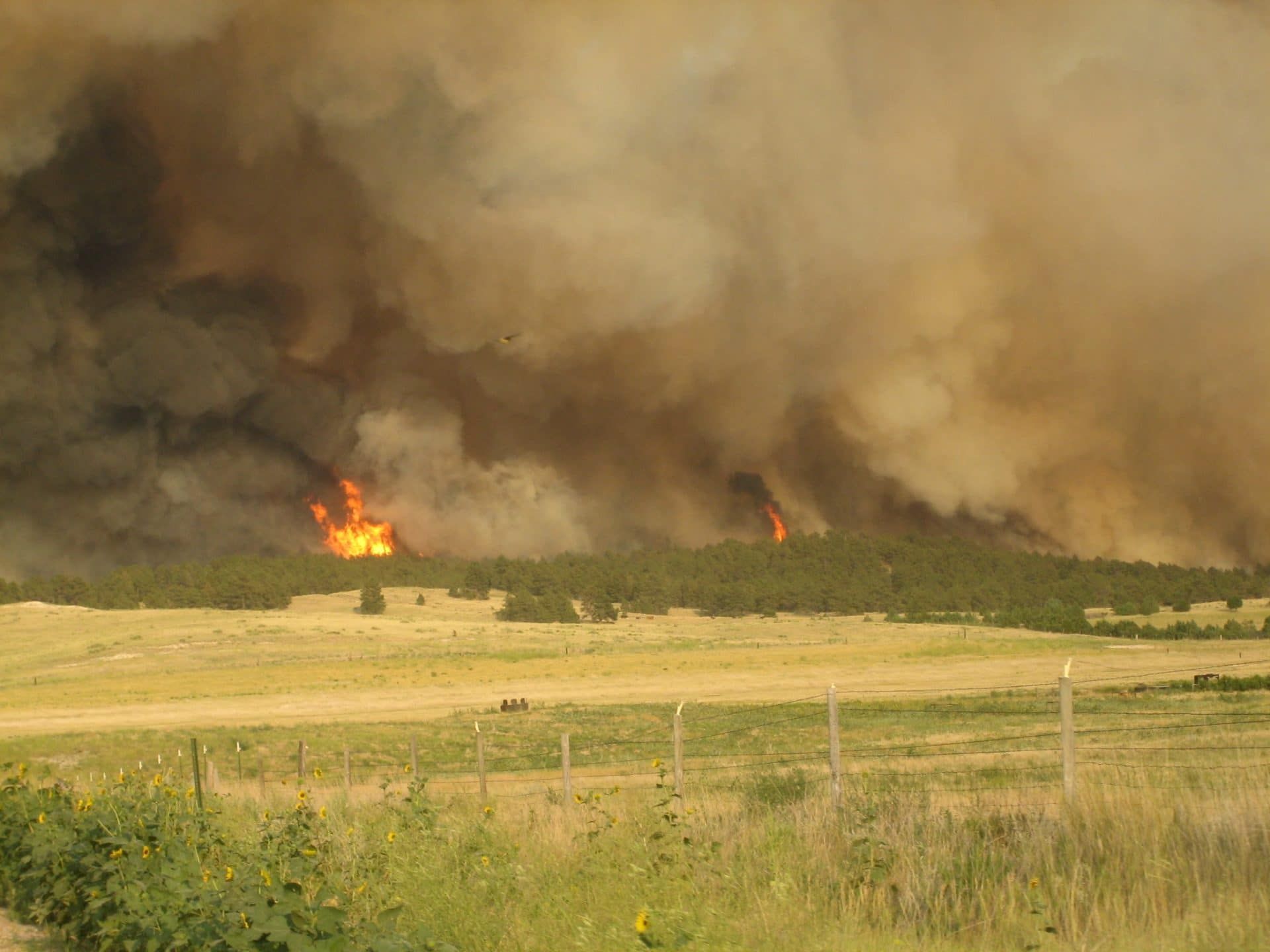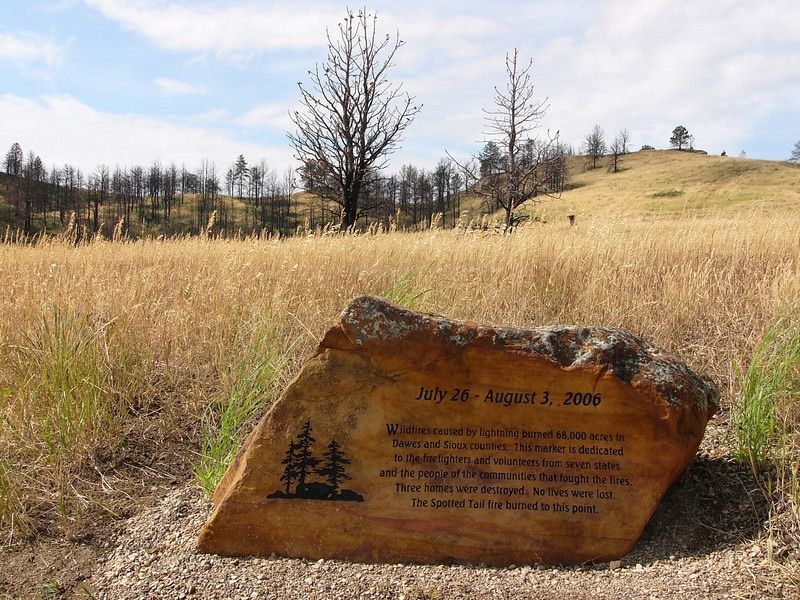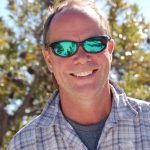Climate change and the coronavirus are upending the way we fight wildfires
By Don Whittemore | April 29, 2020
 The author during his time as a firefighter
The author during his time as a firefighter
In July 2006 I nearly died fighting a wildfire on the outskirts of Chadron, Nebraska. Almost as quickly as the fire blew up and trapped me in a fully engulfed house, my worldview of disasters and how we respond to them was reduced to ruins—along with the house that momentarily sheltered me.
The so-called Spotted Tail Fire erupted on an abnormally hot, dry, and windy day. Before going out to scout the fire, I met with the fire management officer from the Nebraska National Forest, a weathered firefighter who was months away from retirement after spending his entire fire career in the hills of western Nebraska. He described to me how fires behaved in the Nebraska forest, orienting this Colorado-based firefighter to what I should expect in terms of fire intensity, spread rates, and tactical options. He concluded his comprehensive download of experience and wisdom with a nonchalant “…but we’ve never seen it this hot and dry here before.” Dismissing this seemingly inconsequential afterthought nearly cost me my life.
What happened later that day forever changed the way I think about fire behavior, as well as the entire landscape of natural disasters. I now understand that the climate is changing in ways that put me and my fellow firefighters at greater risk than ever. And in 2020, the complicated task of managing wildfires and other disasters has become truly complex: The coronavirus pandemic is forcing incident managers to rethink and rewrite virtually every approach, plan, and strategy.
Weather is a key factor for wildfires. In its most simple characterization, fire behavior is a product of the interplay between three natural features: fuels (typically vegetation such as grass, shrubs, and trees); weather (namely temperature, relative humidity, wind, and atmospheric stability); and topography (principally slope and geographic features such as canyons). Of these, weather is the most dynamic, variable, and influential. Its hourly, daily, seasonal, and year-to-year or decade-to-decade variations constantly shape fire behavior characteristics such as the availability and susceptibility of fuels to ignite and burn, the rate and direction of fire spread, flame lengths, and fireline intensity (a measure of how much heat the fire is generating, expressed in BTUs per feet per second). Weather not only sets the wildfire stage, but orchestrates the performance, and, in the case of large fires or long fire seasons, determines when the curtain falls.
One of the most challenging aspects of fire behavior is that a change in any of the three primary factors (fuels, weather, or topography) can have deadly consequences. A one-degree increase in temperature or a one-percent decrease in relative humidity, for example, does not necessarily result in an incremental change in fire behavior. Rather, the effects are often disproportionate and asymmetrical. When that veteran firefighter in western Nebraska admitted he had “never seen it this hot and dry,” what he really meant was “I can’t tell you how fires behave in western Nebraska under these conditions.”

Simply unimaginable. As it turns out, I survived what at the time was an emerging occurrence in the wildland fire environment: an area ignition, where several acres or square miles ignite all at once because of a complex chain reaction of thermal radiation, preheating of fuels, atmospheric carbon loading, strong winds, and sudden instability of the atmosphere. Imagine filling your woodstove, getting it roaring hot, tamping it down for several hours and then all at once cranking open the air inlets and the flue. Whoosh!
Moments before the area ignition, I stood transfixed, staring out through a 12-foot-wide glass patio door into a dark black smoke column that had obliterated the 6 pm July sun. I was utterly mesmerized by a blizzard of orange embers driven horizontally across my view. Then, abruptly and violently, the proverbial flue was opened, and my entire field of vision was filled by a twisting, undulating, angry fire ball. A bedroom window on the south side of the house shattered, and the fire entered the home. Not only had a large area of ponderosa pine trees and grasses surrounding the house instantaneously erupted in fire, the very atmosphere itself ignited. In all my years fighting wildfires across the United States, I had never experienced anything like it. It was simply unimaginable.
That word—unimaginable—now makes frequent appearances in news coverage of disasters around the globe. Professionals and laypersons alike regularly describe the scope, scale, magnitude, and consequences of contemporary disasters as “unimaginable.” Unfortunately, it’s not just in our imaginations that the wildfire problem is escalating.
A changing fire regime. In 2015, a group of US Forest Service researchers and their colleagues in academia published a paper in Nature Communications in which they documented that, from 1979 to 2013, climate changes were responsible for lengthening the fire season by an average of about 18 percent across about 25 percent of the Earth’s vegetated surface; they reported that the global burnable area affected by long fire seasons had doubled.
California has experienced 14 of its 20 largest wildfires on record over the past 15 years; 10 of those 15 years are among the 15 warmest years on record in the western United States. The first part of the Fourth National Climate Assessment, published in 2017, states that the area burned by large fires in the western United States doubled between 1984 and 2015. According to the Center for Climate and Energy Solutions, for much of the West “projections show that an average annual 1 degree C temperature increase would increase the median burned area per year as much as 600 percent in some types of forests.”
Despite significant evidence that the scale of wildfires is increasing substantially, the game plan for handling these fires remains largely unchanged. Government officials and the public are inclined to see each event, such as the recent fires in Australia, as an aberration—and to overlook that these aberrations are actually becoming the norm.
A reconstructed worldview. Since that near-fateful day in Nebraska, my worldview of disasters has been demolished and slowly reconstructed. Over the past 4.54 billion years, Earth has survived wildfires, floods, earthquakes, ice ages, volcanic eruptions, and a multitude of other cataclysms. These so-called disasters, in the absence of humans and all of our social constructs, can simply be regarded as fascinating natural cycles and occurrences. It is only when we put people, homes, infrastructure, economies, political affairs, and other social values within proximity to these events that they compel the disaster label. I have come to believe there are no such things as “natural disasters,” only natural events with disastrous social consequences.
Over the past 150 years, humans around the world have instigated chain reactions on a global scale, with interactions between a multitude of environmental and social components that are becoming more volatile, uncertain, chaotic, ambiguous, and novel. Indeed, through our folly, we have tipped the ecological and evolutionary scales in favor of failure, with the social consequences and implications of natural events accelerating more rapidly than sociopolitical systems’ ability to adapt. In much the same way that the interplay between fuels, weather, and topography influences fire behavior, the spontaneous, cumulative, and exponential effects of environmental and social interactions produce outcomes well in excess of the sum of these parts.
The coronavirus challenge. As if the task of managing modern wildfires and other disasters hasn’t been challenging enough, COVID-19 adds yet another novel dimension. In an April 3 memo to senior leaders, US Forest Service Chief Victoria Christiansen wrote: “We are operating in a time of extreme uncertainty, and we need to adjust our decisions and actions… We are changing how we approach fire management options during the COVID-19 pandemic across the board to adjust to this unprecedented challenge.”
Indeed, every aspect of fighting and managing these incidents will require alteration. Fire camps, where upwards of several thousand firefighters eat, sleep, and work in extreme close proximity for weeks at a time, will need to be rethought. Evacuation centers that provide temporary refuge for those displaced by natural disasters, in similarly tight quarters, will need to be reimagined. Wildfire smoke will further challenge individuals with respiratory illnesses and diseases. The list of impacts, consequences, and threats is simply mind-boggling.
Flattening the curve. In 1963, Herbert York, a nuclear physicist who became the first director of the Lawrence Livermore National Laboratory, testified before a US Senate committee regarding the nation’s steadily growing military power and steadily diminishing national security. In thinking about the rapidly growing threats to social systems and constructs posed by disastrous effects of climate change and interrelated disasters, I find York’s insights as apropos today as they were 57 years ago: “I am optimistic that there is a solution to this dilemma; I am pessimistic only insofar as I believe there is no solution to be found within the areas of science and technology.”
Today’s unimaginable disasters cannot be solved with technological or scientific advances alone. Such advances are not a substitute for a society’s collective will to alter the current climate trajectory—to “flatten the curve,” as pandemic experts say. The contemporary approach to firefighting is akin to simply building more, bigger, and stronger bomb shelters. We may survive the battle, but most assuredly we will lose the war.

Survival. The story of how I survived the Spotted Tail Fire is no different than surviving the novel challenges we face with wildfires, climate change, and COVID-19 today. What do you do when you don’t know what to do?
The roof over the garage where I was sheltered began raining embers on me. The only clear air I could find was by pressing my lips to the cool cement floor. The space that had temporarily protected me from the fully engulfed home was quickly becoming my tomb. My prospects had become quite doubtful. I knew no heavy air tanker would be coming to dump a load of retardant on the fire; no engines and skilled firefighters were coming to my rescue.
In the end, the solution to unimaginable problems can often be found in one’s imagination. Lying on the cement slab, I shifted my focus from the fire inside the structure to the fire outside. I thought about the grasses and tree crowns that had been burning. I thought about burn times under wind-driven fires. I thought about time and distance and imagined the fire moving across the landscape: where it was and where it might no longer be.
I rose from the garage floor and risked a hasty glimpse out the vestibule door. Yes, it was still hot and smoky, but most importantly, it was dark—and dark meant little to no flame. My second glimpse out the door was more prolonged and inspired my third and final opening of the door. I simply stepped out into my future.
In his 1962 book The Savage Mind, Claude Levi Strauss introduced the notion of bricolage, the ability to use whatever is at hand to develop something new. This could fit the job description of a traditional engineer, but Levi Strauss envisioned it as something more. It wasn’t just something technological or scientific; it also included a holistic thought process.
How does one take what one knows and generate a new way of thinking? As novelty and the unimaginable increasingly become the norm, a new way of thinking might well be what is needed most.
Together, we make the world safer.
The Bulletin elevates expert voices above the noise. But as an independent nonprofit organization, our operations depend on the support of readers like you. Help us continue to deliver quality journalism that holds leaders accountable. Your support of our work at any level is important. In return, we promise our coverage will be understandable, influential, vigilant, solution-oriented, and fair-minded. Together we can make a difference.
Keywords: COVID-19, Coronavirus, climate change, fires, wildfires
Topics: Biosecurity, Climate Change, Opinion















